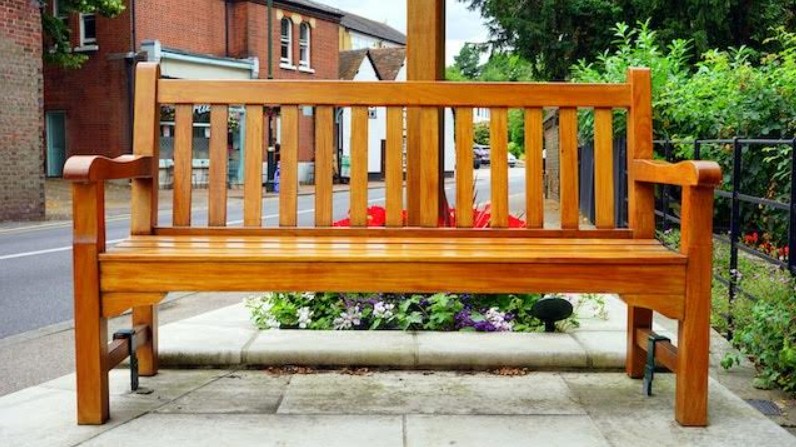
Offering both comfort and design, a well-kept wooden bench is a classic addition to any yard or patio.
Over time, external factors can cause bending, fading, and general deterioration. Proper care is essential for keeping your outdoor seats in top condition. Occasional treatments also help preserve their durability and appearance.
Preserving both longevity and appeal requires frequent maintenance, whether it is cleaning, guarding against moisture, or adding a finish.
Understanding Different Wood Varieties
Different types of wood are used to manufacture bench seats, each offering unique benefits.
For instance, teak is quite well-liked outdoors, as it is strong and naturally resists water. Also, cedar smells pleasant and drives off insects. Despite being cheaper, pine requires extra attention due to its softer nature.
Moreover, hardwoods such as teak are better able to withstand poor weather than softwoods, such as pine, which can bend or break. Knowing the different characteristics of timber will help you determine how to keep it looking fresh.
Essential Cleaning Tools and Materials
Preparing for a thorough clean involves gathering the right items first to ensure the process is smooth and efficient.
Utilise a soft brush to gently sweep away dirt without scratching the wood. You will also need a sponge and some warm water in a bucket to apply cleaning agents evenly on the bench.
Furthermore, use nontoxic cleaners such as vinegar and olive oil or mild soap, as they are effective and gentle on the structure.
Avoid rough materials that could damage the wood over time. Remember that employing a protective cloth is useful to prevent splashes from spreading. Additionally, a pair of gloves will be practical to keep your hands safe and comfortable.
Detailed Cleaning Instructions
Start by removing any loose dirt or debris, especially from behind the seat cushions. Trapped particles can hold moisture, which ultimately causes unpleasant stains.
Mix warm water with a small amount of mild soap in a bowl, or use a blend of vinegar and olive oil as a natural alternative.
Using a soft sponge, gently rub the entire surface, including corners, ensuring even coverage from all angles.
Never allow absorbent fabrics to soak up water because excessive wetness can damage the wood structure.
After cleaning, be sure to rinse the bench with fresh water to eliminate soap residue. Lastly, dry the surface using a soft towel to prevent warping.
Weatherproofing Your Wooden Seat
Applying a protective finish helps your wooden bench withstand outdoor conditions. Products like sealants or oils can assist the wooden components in remaining free from sun damage and moisture.
You should do this after giving the structure a good clean and perhaps refresh it every six to twelve months, depending on the weather in your area.
Consider using weather-resistant oils like teak or linseed oil, which penetrate deeply and help the wood remain healthy.
When the bench is not in use, particularly during harsh weather, cover it with a tarp or a suitable furniture cover. This will keep it dry and protected from rain and snow.
Dealing with Stains and Scratches
Wooden benches are attractive, but stains and scratches can mar their appearance if not addressed promptly.
Should you happen to spill food or drink, simply create a paste by combining baking soda with water. Once you have applied it to the mark and allowed it to sit for a few minutes, take a damp cloth to wipe it away.
Sand the area gently, following the grain of the wood, using fine sandpaper if there are any scratches. Once it is smooth, touch it up with a matching finish or oil to blend it in.
Moreover, to prevent spills and scratches from occurring, consider using coasters or placemats.
Addressing these minor issues quickly can significantly maintain your bench’s sturdy appearance.
Routine Maintenance for Longer Lifespan
Preserving your wooden bench’s quality requires regular care. Routinely clear away dust and debris that collects over the week. Give it a deep clean once a month to maintain its brightest appearance.
Additionally, every few months, apply protectant oil such as teak or linseed to prevent the wood from drying out, forming cracks, and ultimately deteriorating.
Furthermore, whenever you are not using the bench, especially in harsh weather conditions, store any cushions indoors to prevent mould growth.
Lastly, rotating the bench every few months ensures uniform sun exposure, thereby preventing fading and warping on one side.
Implementing these simple strategies minimises the need for costly repairs, ensuring your bench remains in excellent condition and lasts for years to come.
Assessing the Need for Skilled Intervention
Keeping the look of your wooden bench mostly depends on routine maintenance and cleaning. Still, there are cases when you require the knowledge of experts.
Your bench probably requires professional assistance if it has major scratches, tough stains, or faulty components.
Specialists can provide a comprehensive cleaning service, revitalising your bench’s appearance and restoring its gleam.
Moreover, it is wise to seek local technicians experienced in restoration. Trained individuals in outdoor care can clean and refresh wooden benches to protect against weathering.
They also offer custom treatments, such as oiling and sealing, to improve durability and maintain long-term quality.
Engaging skilled technicians saves time and prevents potential damage, enhancing your bench’s longevity and overall aesthetic appeal.
Eco-conscious Upkeep Alternatives
Adopting a mindful approach to handling outdoor wooden furniture benefits both its longevity and the environment.
Using natural wood conditioners like linseed or teak oil protects the wooden surface and enhances its durability without using harmful chemicals.
A DIY cleaning solution can be prepared by mixing water and vinegar, providing an accessible, chemical-free, and gentle method to remove stains.
Furthermore, in terms of efficiency, sustainable approaches are on par with conventional ones. Natural oils penetrate the wood just as deeply as chemical-based sealants. They provide long-lasting protection against moisture and weather damage.
Additionally, opting for biodegradable soaps further minimises environmental impact while keeping your bench clean and well-preserved.
Likewise, repurposing old cloths instead of disposable wipes reduces waste and promotes a more ecological routine.
Conclusion
Caring for your wooden bench is simpler than you might think, and with regular treatments, it will stay beautiful for years. By following simple habits, you can easily keep it looking great without incurring high costs.
Ensure your benches stay clean, protect the wood, address any marks or discolouration promptly, and seek expert help when needed.



